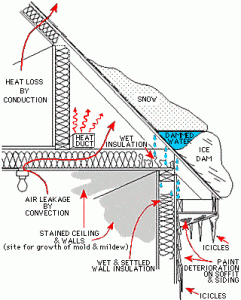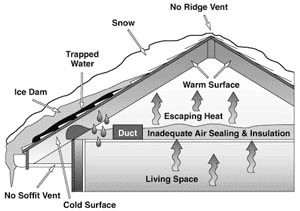We don’t have to worry about it too much in the south, but ice hanging around on your home can cause serious damage. As the icicles from our first winter storm of this year melt, homeowners can see how a threat of moisture is lurking around their homes during the winter months when snow and ice are hanging around, thawing, and refreezing as the temperatures fluctuate.
Ice dams occur when giant icicles accumulate along the eaves of a home. They can pose a danger to people walking below. According to a very informative article published by Battic Door Home Energy Conservation Products, large ice dams along your roofline can be indicative of moisture problems with a roof, or accumulation of water inside of the attic.
Your attic should be very cool and dry in the wintertime. However if your attic is improperly insulated or sealed from the living space of your home, it can become a warmer and moist environment. The snow accumulating on the roof will melt rapidly if it is against a warm attic, and quickly refreeze as it runs to the gutter of your home. That’s how ice dams are made.

If your roof is not good, your attic is probably not as dry as it should be. But let’s say you have a great roof, and your attic still feels humid and warmer than it should. You might have issues with condensation. Make sure any access from your home’s interior space to the attic are properly sealed so that air is not circulated from your warm home into the attic, a space that is supposed to be dry and cold. Check for holes or improperly sealed attic access points and also check your attic for moisture and mildew using a flashlight and making sure the rafters are dry to the touch.
Icicles Are Pretty! How Can They Be Bad?
Icicles don’t hang around on our homes for very long here in the south where, after a nice cold snap, things tend to warm up fast, and the pretty icicles melt away fast. However, be warned that if you see a ridge of ice along the ridge of your roof and it’s hanging around for a long period of time, that can be a terrible thing for your house. It can serve as an obstruction preventing melting snow and water from draining properly off of your roof. Rather than draining away from your home, that backed up moisture could be entering your home. If you notice that the pretty icicles are not melting away as quickly as they should be, it’s time to make sure you are not having a moisture problem in your home.
What Causes This Problem?
Heat loss from your home, the inconsistent roof temperatures that creates, combined with a generous covering of snow or ice during freezing outdoor temperatures are the conditions that cause part of the snow or ice on the roof to melt, then refreeze on the portions of the roof that remain cold. The water will freeze on the consistently cold (below 32degrees) portions of the roof and cause the water to dam behind it as it melts, potentially seeping into cracks and openings along your roof line and getting inside of your attic From there, it could moisten your walls and ceiling.

Typically heat from inside your home causes varying roof temperatures. Don’t let heat loss happen when you’re paying a lot to keep your house warm inside. Diagnose and fix the problem. What can you do?
- Check the R-value on your insulation and make sure your attic is sufficiently insulated to form a barrier and keep the heat inside of your home.
- Air leakage from your living spaces into the attic of your home can create a transfer of heat or heat loss. Check and make sure that warm air is not leaking out from your rooms.
- Make sure that exhaust systems like the ones in your kitchen or bathroom are not creating inconsistent temperatures by putting warm air onto your roof and causing snow to melt in that area, only to have it flow and freeze again lower on the roof where it dams up more melting snow.
- Your wood stove or fireplace could cause your chimney to be a source of heat in your attic. Also, leaky duct work inside of your attic could create pockets of warmth.
These photos published on Battic Door’s website show examples of obvious warm spots on a roof, causing ice dams:


Enjoy the beautiful snow days, but be aware of what is happening around and inside of your home during the cold months. You might notice some problems that have been overlooked for years. Understanding how to find minor problems that could cause big water damage in your house down the road is a good thing! At Melton Interiors, we see big and expensive problems from the longterm effects of water leakage and moisture all the time. We also know how to assess your home to find the minor issues that can lead to longterm heat loss, water infiltration, and weakening of structure on your home down the road. If you feel like your insulation, roof, and HVAC systems should be checked out, give us a call. We fix damage but we also help you identify construction flaws or wear and tear on your home that requires only minor upgrades and adjustments to stop damage from ever happening.

